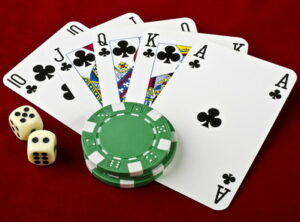 The most exciting moment for many when playing poker is obviously the showdown, especially when you remain in play with a high-ranking hand.
The most exciting moment for many when playing poker is obviously the showdown, especially when you remain in play with a high-ranking hand.
A study for Texas Hold’em analysed 103 million online games and found that 75.7% of the games were decided on the basis of the bets alone, without a showdown. In 49.7% of these showdowns, the hand of a player who had folded would have been the winner; that is, almost a half of them.
For these defensive losers, frustration is high. But when you remain in play to the end with a high-ranking hand that is eventually beaten by a higher-ranking one, your frustration may reach the highest level. We shall see in this article what are the odds for that situation to happen and how they can be estimated.
Bad Beat Jackpots – Rules And Motivation
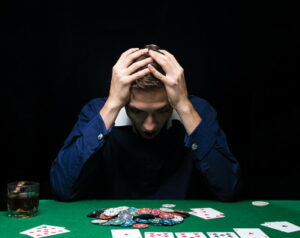 Hold’em poker operators wanted to change the rules so that a bad beat would turn from extreme frustration to a winning situation, so they invented the ‘bad beat jackpot’.
Hold’em poker operators wanted to change the rules so that a bad beat would turn from extreme frustration to a winning situation, so they invented the ‘bad beat jackpot’.
The jackpot collects a small amount of money from each hand during each round of play (in certain conditions) and when a bad beat situation occurs, the jackpot up to that date is shared among the players remaining active at the table. The winning hand receives 20% of the jackpot, the losing hand 40% and the rest is split between the other active players.
In regard to the rules by which a hand qualifies for the bad beat jackpot, they vary among the operators, rooms, and casinos. Usually the bad beat jackpot is paid out when a hand of minimum four of a kind of 5s is beaten by a stronger hand (four of a kind of 6s through aces or a straight flush) and both the winner and the loser use all their hole cards in their final hand.
Giving more money to the loser than to the winner from the jackpot is first a compensation for the former’s loss (and a serious motivation for them not to quit playing Hold’em given their frustration). As for the winner, the prize adds to the already won pot so they must not be too envious on the loser. Nobody loses, everybody wins.
The largest bad beat jackpot in the poker history seems to be recorded in January 2018 in Michigan, U.S., in the amount of $1,068,590. The fighting hands were quad 3s versus quad queens.
But what are the odds associated with such events and how rare are they?
Hold’em Odds And How They Are Calculated
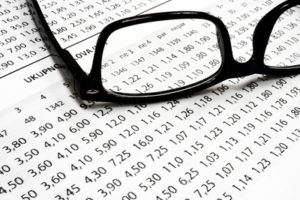 Like in other card games, in Hold’em poker we deal with combinatorial probabilities. that is, probabilities that are computed by counting the combinations of cards favourable for the events in question out of the number of all possible combinations of cards.
Like in other card games, in Hold’em poker we deal with combinatorial probabilities. that is, probabilities that are computed by counting the combinations of cards favourable for the events in question out of the number of all possible combinations of cards.
For many events exact probability computations are possible, manually or by applying explicit formulas. For other more complex events, mathematicians use various techniques of approximation, while other probabilities simply cannot be worked out mathematically due to the hugeness of cases to be categorised and the complexity of the probability spaces involved.
For this latter type of events, odds can be estimated only by random simulation software, which is required to run simulated games in the order of millions or even billions for providing accurate enough approximations.
Since probability of an event changes with every new card dealt, the most relevant probabilities are those worked out in a probability space based on the maximal available information, that is, the number of visible cards. In Hold’em this maximal exposure is obviously attained in the river stage, when 7 cards are visible for the player doing the estimation (five community cards plus their hole cards).
When estimating the Hold’em odds of winning or losing with a certain hand, we deal with conditional probabilities. This means that the event we measure in probability depends on a previous event whose probability also counts in the equation.
Bad beat odds are examples of conditional probabilities: For instance, at a moment before the river, the probability for your hand to be beaten at the showdown if you will achieve four of a kind of, say, jacks, requires first the probability for you to achieve that hand by the river, and then the probability of an opponent beating it, if you achieved it.
Average Frequency Of A Bad Beat Jackpot
| Bad Beat Hand | Probability Hand Beaten | Average frequency |
|---|---|---|
| Four 5’s or higher | 0.00000805 | 1 in 124,224 rounds |
| Four 6’s or higher | 0.00000705 | 1 in 141,844 rounds |
| Four 7’s or higher | 0.00000613 | 1 in 163,132 rounds |
| Four 8’s or higher | 0.00000525 | 1 in 190,476 rounds |
| Four 9’s or higher | 0.00000439 | 1 in 227,790 rounds |
| Four T’s or higher | 0.00000359 | 1 in 278,552 rounds |
| Four J’s or higher | 0.00000287 | 1 in 348,432 rounds |
| Four Q’s or higher | 0.00000226 | 1 in 442,478 rounds |
| Four K’s or higher | 0.00000180 | 1 in 555,556 rounds |
| Four A’s or higher | 0.00000149 | 1 in 671,141 rounds |
| Any straight flush | 0.00000122 | 1 in 819,672 rounds |
Table 1
If we just ask how frequent we should expect a bad beat jackpot to be at a poker table, this could be answered only by executing a long random simulation. The table above shows a few results of such a simulation (of about 2.5 billion rounds for each bad beat hand).
The simulation assumed a 10-player game in which nobody folds. The probability is for any player qualifying for the jackpot with that hand under the usual rules. If you want the probability of a specific player losing with that hand (or you), you should divide the results by 10.
Translating the approximated probabilities above in terms of average frequency returns the results in the third column. For instance, four-of-a-kind of 5s or higher hand occurs and is beaten in average about once in 124,224 rounds.
But such figures are not of much relevance. They are just illustrative to make an idea about how low are the odds of a high-ranking hand to be beaten, even at a full table.
First, the simulation runs in ideal conditions; in reality, there is bluffing, folding, and the showdown taking place at a full table, so this is an astronomically rare event. Second, the method does not take into account available information, that is, the configuration of the board (they are a sort of apriori probabilities).
Third, from the standpoint of a player, the odds for a high-ranking hand to be beaten are of no use for them as long as that hand has not been yet achieved. We saw that the probability of a bad beat jackpot is conditional and this is why we should be first concerned with the probability of hitting the hand that qualifies for the bad beat jackpot.
Quads And Straight Flush Odds From Preflop To River
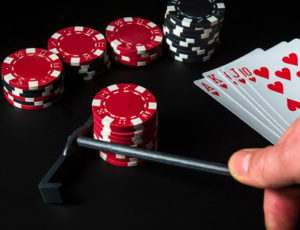 Considering the progression of the game, we can compute conditionally the odds for your own hand and in certain situations for your opponents’ hands, by using the available information that gives relevance to the numerical results, namely the cards on the board and your pocket cards.
Considering the progression of the game, we can compute conditionally the odds for your own hand and in certain situations for your opponents’ hands, by using the available information that gives relevance to the numerical results, namely the cards on the board and your pocket cards.
Let’s start at the beginning:
In order for you to achieve four of a kind (of 5s or higher) qualifying for the bad beat jackpot, it is necessary first to be dealt a pair of 5s or higher. The odds for being dealt a certain pair are 0.452% and the odds of being dealt any pair from 5s through aces are 0.452% x 10 = 4.52%. Pretty low, right?
How about the straight flush? It requires for you to be dealt suited cards differing in value with less than 5 points (for belonging to a straight).
Each possible straight holds C(5,2)=10 such two-card combinations and we have 40 possible straight flushes. The odds of that happening are then (40 x 10)/C(52,2) = 400/1326 = 30.15%.
Pretty high, but don’t get too excited if you are dealt such a hand. There are three more specific cards to be dealt on the board for you to hit the straight flush.
Assume now that you were dealt a pair of 5s or higher and move now to the flop stage. What are the odds of improving your hand for hitting the quads by river? The odds of flopping one card paired with your pocket cards are 11.51% and the odds of flopping all two remaining (hitting the quads in flop) are 0.244%.
For the straight flush, computation is more difficult. Assuming you were dealt two suited cards from one (or more) straight flushes of that suit, here are the odds of improving that expected hand in the flop:
| No. of possible straight flushes | One card | Two cards | Three cards |
|---|---|---|---|
| 1 (for instance, A♥2♥3♥4♥5♥ when holding A♥5♥) | 0.1654591 (16.545%) | 0.0071938 (0.719%) | 0.0000510 (0.005%) |
| 2 (for instance, 3♥4♥5♥6♥7♥ and 4♥5♥6♥7♥8♥ when holding 4♥7♥) | 0.2112244 (21.122%) | 0.0140816 (1.408%) | 0.0002040 (0.020%) |
| 3 (for instance, 4♥5♥6♥7♥8♥, 5♥6♥7♥8♥9♥, and 6♥7♥8♥9♥10♥ when holding 6♥8♥) | 0.2525510 (25.255%) | 0.0229591 (2.295%) | 0.0005102 (0.051%) |
| 4 (for instance, 7♥8♥9♥10♥J♥, 8♥9♥10♥J♥Q♥, 9♥10♥J♥Q♥K♥, and 10♥J♥Q♥K♥A♥ when holding 10♥J♥) | 0.2895918 (28.959%) | 0.0336734 (3.367%) | 0.0010204 (0.102%) |
Table 2
Assume now you are waiting the turn card with chances to hit quads or straight flush by river.
For quads:
■ If no card paired with your pocket cards was flopped, you need the turn card to be paired. The odds of that are 2/47 = 0.04255 = 4.25%.
■ If one flop card improved your quads draw, the odds to hit the quads with the turn card are 1/47 = 0.02127 = 2.12%.
Now for straight flush:
■ If one card improving your straight flush draw was flopped, the odds for the turn card to continue to improve your draw (as required) are:
2/47 = 0.04255 = 4.25%, if the three cards (your hole cards plus the favourable one flopped) belong to one straight flush;
3/47 = 0.06382 = 6.38%, if the three cards belong to two straight flushes;
4/47 = 0.08510 = 8.51%, if the three cards belong to three straight flushes.
■ If two cards improving your straight flush draw were flopped, the odds for the turn card to complete your draw are:
1/47 = 0.02127 = 2.12%, if the four cards belong to one straight flush;
2/47 = 0.04255 = 4.25%, if the four cards belong to two straight flushes.
Assume now you are waiting for the river card with chances to hit quads or straight flush.
For quads:
Only the case with one card on the board improving your quads draw is worth evaluating (for zero such cards, you have no chance to hit quads and for two cards the quads is already hit).
The odds for the river card to complete your draw are 1/46 = 0.0217 = 2.17%.
For straight flush:
Only the case with one card on the board improving your straight flush draw is worth evaluating. The odds for the river card to complete your draw are:
1/46 = 0.0217 = 2.17%, if the four cards belong to one straight flush and
2/46 = 0.0434 = 4.34%, if the four cards belong to two straight flushes.
Now imagine yourself in the lucky situation when you hit quads (of 5s or higher) or straight flush by river. The odds of that are very low. For quads (of 5s or higher) there is a probability of 0.81% to hit one, before any card is dealt.
For straight flush it’s even lower. Hence it’s obviously a very lucky situation. It’s time now to evaluate the chances for your lucky hand to be beaten.
Bad Beat Jackpot Odds
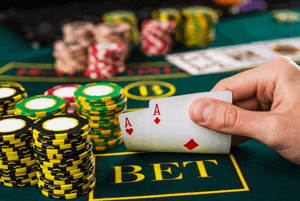 We already know that such odds are minute from the statistical perspective. But let’s see what are these odds as computed at the river stage, just before the showdown, by using the available information on the board and your hole cards.
We already know that such odds are minute from the statistical perspective. But let’s see what are these odds as computed at the river stage, just before the showdown, by using the available information on the board and your hole cards.
Let’s analyse the quads hand. If you hit quads, there is a chance for your hand to be beaten by higher quads only when the board includes a higher pair than the one that your quads consist of. For instance:
- Board: 99JJ2
- Your hole cards: 99
The board can only include two pairs, so for the result it does not matter what is the value of your pair or of the higher pair.
The probability for one opponent to hold that higher pair as their hole cards is 1/C(45,2) = 1/990 = 0.00101 = 0.101%. Since no two opponents can hit the same quads, the probability that your quads will be beaten by higher quads increases linearly with the number of opponents:
| No. of opponents | Probability that your quads will be beaten by higher quads, if a higher pair is on the board |
|---|---|
| 1 | 0.00101 = 0.101% |
| 2 | 0.00202 = 0.202% |
| 3 | 0.00303 = 0.303% |
| 4 | 0.00404 = 0.404% |
| 5 | 0.00505 = 0.505% |
| 6 | 0.00606 = 0.606% |
| 7 | 0.00707 = 0.707% |
| 8 | 0.00808 = 0.808% |
| 9 | 0.00909 = 0.909% |
Table 3
But your quads may be also beaten by a straight flush, if the board allows that hand for your opponents. The condition is to have three suited cards from one or more straight flushes on the community board. For instance:
- Board: 9♥9♣J♥J♦7♥
- Your hole cards: 9♦9♠
An opponent holding 8♥10♥ will beat your quads, as well as one holding J♣J♠.
The following odds apply under the condition above:
■ If your hole cards include none of the cards of the possible straight flushes (like in the example above), the probability for one opponent to have a straight flush is:
1/990 = 0.00101 = 0.101% if one straight flush is possible;
2/990 = 0.00202 = 0.202% if two straight flushes are possible;
3/990 = 0.00303 = 0.303% if three straight flushes are possible;
■ If your hole cards include one of the cards of the possible straight flushes, the probability for one opponent to have a straight flush is:
0 if one straight flush is possible;
1/990 = 0.00101 = 0.101% if two straight flushes are possible;
2/990 = 0.00202 = 0.202% if three straight flushes are possible.
At most two opponents can have straight flush. The probability that at least one opponent has a straight flush does not increase linearly with the number of opponents, however the probability that two opponents have straight flush is so low (0.0000402) that the linear approximation is accurate enough.
Overall, one opponent will have a straight flush with 0.101% – 0.303% probability, and at least one opponent will have one with a probability ranging in 0.101% – 2.72%, with the maximum attained for 9 opponents in the situation in which there are three possible straight flushes and your hole cards contain none of their cards.
Adding together the odds for quads and for straight flush and staying with the maximal value, we get that the probability of your quads to be beaten does not exceed 3.63%. This maximal value applies to a particular and rare situation, but usually the overall probability is much lower, in most of the situations under 1%.
We move now to the straight flush hand. The probability for your hand to be beaten by an opponent with a higher straight flush can only have two values, namely zero and 1/990 = 0.00101 = 0.101%. The non-zero probability applies to the following general case: The three cards on the board participating to your straight flush belong to three possible straight flushes (so they are consecutive in value), your straight flush is the lowest among them and none of the remaining two cards of the highest straight flush is on the board.
For instance:
- Board: 4♦5♦6♦8♣Q♦
- Hole cards: 2♦3♦
(One opponent holding 7♦8♦ will beat it.)
Whatever the case, only one opponent may beat your straight flush, so the probability that at least one opponent will beat it increases proportionally with the number of opponents (The values in Table 3 also apply in the straight flush case.)
Now, let’s take stock and see what all these odds are telling us.
Statistics based on simulations showed that the odds for a bad beat jackpot are extremely low (one in hundreds of thousands). This is confirmed by the probability of less than 1% of hitting either quads or straight flush by river to qualify for the jackpot.
If you are lucky enough to be dealt a good pair or two suited cards for straight flush, odds to improve them increase, but overall they remain low. If you reached the luckiest situation when you hit quads or straight flush by river against the odds, the odds for your hand to be beaten are usually under 1% and increase with the number of opponents remained in play, to an upper limit of 3.63%.
This limit is actually not applicable, since such hands are all-in hands that make many opponents fold before the river.
Given the rules of the bad beat jackpot, these latter low odds don’t look like being always in your favour. If the jackpot is higher than the table pot of the round in play, it may be an advantage to be beaten for and taking the highest share of the prize. More precisely, the jackpot should be five times bigger than the table pot for the hand loser to be in advantage.
References
- Bărboianu, C. (2011). Texas Hold’em Odds for your strategy, with probability-based hand analyses. Infarom.
- Bewersdorff, J. (2021). Luck, logic, and white lies: The mathematics of games, second edition. CRC Press.
About The Author
The author of this page is Dr. Catalin Barboianu. Catalin is a mathematician specialising in gaming and responsible gambling and a research associate at the University of Bucharest.
